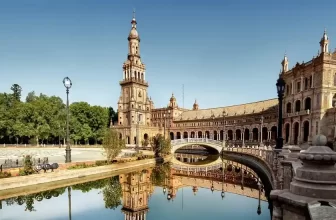
The first thing that hits you when you step out into Granada isn’t just the air-it’s the layers of scent and sound. You’ve got warm spices wafting from tucked-away tapas bars, live flamenco echoing down ancient alleyways, and crisp mountain air that somehow sneaks past the Andalusian heat.
I remember arriving by bus from Madrid. Pulled into the station mid-afternoon, completely exhausted but wired with adrenaline. My backpack was way too heavy, my Spanish was embarrassingly basic, and my phone was at 3%. I asked a woman at the newsstand “¿Dónde está la universidad?” She replied in a blur of Andalusian Spanish and pointed at a tram. Blessed.
That first ride into the historic center? Unreal. You pass orange trees. Stone walls. Actual palaces. And then boom-Sierra Nevada mountain range in your peripheral. It looks like a painting.
By the time I reached my accommodation (somehow hidden behind a tapas bar and a vintage record store), I’d already seen four different street musicians and been invited to two language exchange meetups. Day one.
If you’re seriously considering getting your overseas education in Granada, and you want more than just Pinterest nightlife or polished university rankings-this is the study guide in Granada you’ll actually refer to. Let’s get you prepped for everything from tuition to tapas.
Why Study in Granada in 2026?
- Spain hosted over 220,000 international students in 2025, with Granada consistently ranking in the top five most popular cities thanks to its affordability and lifestyle
- The University of Granada (UGR) alone has 60,000+ students, with a huge chunk (~12%) being international
- The government continues to fund projects linked to renewables, AI, cultural diplomacy, and global health, particularly through partnerships in Southern Spain
- Spain’s long-standing post-study visa extensions still apply in 2026-so you can stay for up to 12 months after graduation to find work
Personal + Career Wins:
- Cost of studying in Granada is low-public uni tuition starts around €750/year
- Post-grad job growth is centered around tourism tech, translation, IT, environmental research, and European affairs
- You’ll genuinely grow as a person-especially if you’re open to community living, language immersion, and slow-paced, connected life
2026 is the sweet spot: stable visa policies, increasing scholarship programs, and the digital nomad culture boosting Spain’s appeal to young internationals.
Why Granada Works So Well for International Students
Let’s be honest-Granada sits in that rare academic sweet spot. Big enough to be exciting. Small enough to not chew you up and spit you out.
Diverse Student Life & Support Systems
- University of Granada is ranked top 10 in Spain and in the top 500 globally
- Thousands of students arrive each semester through Erasmus+, joint-degree, and master’s programs
- UGR has an entire Vice-Rectorate of Internationalization to help with onboarding, student support services, housing pointers, visa help, and more
- There are language buddy programs, orientation weeks, and free conversational Spanish classes through the Centro de Lenguas Modernas
The City is Made for Students
Student discounts? All over the place-from museums to metro passes. The food caters to broke students (free tapas with your drink, hello), and locals are used to the constant flux of international arrivals.
You’ll hear five languages on a 10-minute walk and most landlords don’t even blink when you say you’re a student.
You’re not just tolerated here-you’re part of the ecosystem.
Academic Opportunities
- Programs are expanding in cybersecurity, gender studies, EU affairs, and Arabic & Islamic Studies (makes sense-Granada has deep Moorish cultural ties)
- Access to international degree programs taught fully in English is growing
- The uni is big on internships, research mobility, and joint diplomas with Germany, France, and North African regions
Top Universities and Colleges in Granada
Let’s not pretend this city is jam-packed with dozens of universities-it’s all about the big one here. But don’t let the lack of choice fool you. This isn’t a compromise. If anything, Granada is a model for affordable, high-caliber, international education in Spain.
University of Granada (Universidad de Granada – UGR)
- Ranking: Top 10 in Spain / Top 500 globally (QS 2025)
- Student population: Over 60,000 students, ~12% international
- Tuition for international students:
- Bachelor’s: €700–€2,100/year (non-EU slightly more)
- Master’s: €1,500–€3,500/year
- Note: Some programs offer tuition fee reductions under exchange or Erasmus+ schemes
- Known For:
- Arabic & Islamic Studies
- Translation & Interpreting
- Computer Science + Engineering
- BioHealth Sciences
- Law, Political Science, European Affairs
- Vibe: Super diverse, laid-back, historically rooted yet academically forward
- Campus layout: Multi-campus city-different faculties scattered throughout various neighborhoods (more on that in the next section)
I studied Comparative Literature here, and I remember thinking, “Wow, that guy in my Arabic class was literally a diplomat’s kid.” That’s Granada. Local and global all at once. Also, the professors know their stuff-some helped build the EU’s intercultural curriculum.
ESADA – Escuela Superior de Arte y Diseño de Andalucía
- Private design school with programs in graphic design, interior design, product innovation
- Less well-known internationally, but benefits from Erasmus+ networks and tight-knit studios
- Tuition: ~€6,000–€8,000/year
- If you’re creative and want smaller class sizes + portfolio building, this could be worth it
Top Student Accommodation in Granada
There are two types of students in Granada:
- Those who book housing six months ahead
- Those who crash on a sofa for two weeks while they figure it out (me)
Learn from both. Start early. Know your options. But don’t stress-deals pop up regularly.
Livensa Living Granada
- Private, modern student residence near the city center
- Cost: €700–€850/month (bills included)
- Perks: Ensuite rooms, gym, coworking space, rooftop views of the Alhambra
- Ideal if you want comfort + international neighbors
Shared Flats (Pisos Compartidos)
- Most common and budget-friendly
- Average cost: €250–€400/month for a room depending on neighborhood and flat age
- Websites to check: Idealista, Fotocasa, Badi, plus local Facebook groups
- Tip: Ask if utilities are included-some landlords leave that vague
Colegio Mayor Universitario Santa Cruz la Real
- Traditional dorm-style but modernized (university affiliated)
- Full board (3 meals/day)-price: ~€700/month
- Pros: Walking distance to central campus, structure
- Cons: Limited privacy, curfews in some buildings (yep, still a thing)
Homestays
- Much rarer in Granada unless you’re doing a short-term or language immersion
- Expect ~€400–€500/month with food
- Language skills + culture immersion
- Reach out via language schools or Centro de Lenguas Modernas
Best Neighborhoods to Live in Granada as a Student
Real talk: choosing the right barrio (neighborhood) makes or breaks your entire uni experience.
Realejo
- Historic Jewish quarter
- Full of quirky cafes, vintage stores, cozy plazas
- Walking distance to most central campus buildings
- Rent: €300–€450/month per room
- Good for Arts, Humanities, or language students
Cartuja
- THE student neighborhood-tons of shared flats, especially near Philosophy, Education, and Science faculties
- Cheap bars, kebab places open till 4 AM
- Rent: €250–€350/month
- The downside? Hilly. And cold AF in winter in older flats with bad heating
Albaicín
- GORGEOUS Moorish vibes. Cobbled streets. Views for days.
- Apartments are charming but old-check heating + internet
- Rent: Very mixed-€250–€500 depending on tourist traffic and landlord
- Not ideal for daily trips uphill if you’re an early class person
Zaidín
- Further south, more local/working class, less touristed = cheaper rent
- 15–20 mins from central campus by bus or bike
- Rent: €200–€350/month
- Great if you prefer quiet, residential vibes + no tourist disruption
Cost of Living in Granada
This is going to vary based on lifestyle, but here’s what students are actually spending day to day in 2026:
| Category | Low (€) | Average (€) | High (€) |
| Rent (shared flat) | 250 | 350 | 500+ |
| Groceries & supermarket | 120 | 150 | 200 |
| Transport (Bonobus monthly) | 25 | 35 | 35 |
| Phone + WiFi | 25 | 35 | 50 |
| Eating out + Social life | 50 | 100 | 150+ |
| Books/supplies | 20 | 30 | 60 |
| Gym/Healthcare (SSN) | 20 | 40 | 60 |
| Monthly Total | ~510 | ~740 | ~1,050+ |
Budget Tricks That Worked for Us:
- Bonobus pass: €35/month with unlimited rides-totally worth it
- Tapas hack: Buy a €2.50 beer and get a free plate of food-welcome to Granada
- Study at public libraries or Centro de Lenguas Modernas to avoid café costs
- Use Wallapop (Spain’s version of Craigslist/Facebook marketplace) for cheap furniture and textbooks
Scholarships & Financial Aid for International Students
Let’s be honest-Granada is already one of the cheapest university cities in Spain. But combine that with the right scholarships, and you could literally live here for less than your current rent back home.
University of Granada (UGR) Scholarships
- UGR International Mobility Grants
Available for Erasmus+, SICUE, and non-EU students in bilateral programs
Usually covers part of tuition, plus monthly living stipend (~€400–€900/month) - Master’s Program Merit Scholarships
Offered for selected programs like Artificial Intelligence, Gender Studies, and Global Business
Based on GPA and motivation letter - Language Course Reductions
Students enrolled in regular UGR degrees get reduced fees for Spanish + Arabic classes
🇪🇺 National/Regional Financial Aid
- MEFP Grants (Spanish Government)
You apply during spring/summer; need NIE + academic proof + income docs - Andalusian Regional Scholarships
Often lesser-known but great support towards tuition or books
Ask the campus student support services for help filling them
Scholarship Tips That Actually Work:
- Don’t over-polish your motivation letter. Make it real. Honest. Personal.
- If they ask for language proficiency – get your DELE A2/B1 or IELTS, even if not mandatory
- Ask professors early for references. Don’t rely on AI-generated letters (they sound fake)
- Talk to current scholarship holders-they know tricks that nobody writes about in official docs
How to Apply – (2026 Intake)
At first, applying to study abroad feels like solving a Rubik’s cube in a language you don’t fully understand. I get it. So here’s how to shortcut the confusion:
Step-by-Step Application Process:
- Research and Shortlist Programs (Oct–Dec 2025)
- Use the UGR website and Spain’s official university directory
- Check program language, academic calendar, credit system
- Prep Your Docs (Nov–Jan)
- Academic transcripts (translated to Spanish/English)
- Proof of language skills (IELTS, TOEFL, DELE, or university-specific). Most bachelor’s need B1/B2 Spanish, but many master’s are English-taught
- Copy of passport, ID, resume, motivation letter
- Apply via Online Platform (Feb–April)
- For UGR: https://solicitudes.ugr.es/
- Watch your email-responses come in batches, not instantly
- Get Pre-Acceptance + Pay Preliminary Fees (April/May)
Usually a €300–€700 deposit to secure your place - Apply for Scholarships + VISA (May–July)
Most international/non-EU students apply for the Spain Type D Student Visa
Common Mistakes:
- Submitting partial/uncertified documents
- Forgetting to translate transcripts
- Cutting/pasting a generic motivation letter instead of customizing
- Booking your visa appointment too late-it fills up FAST in July
Visa & Work Rules for International Students in Spain (2026)
Okay, this next part sounds scary until you break it down.
Here’s your de-jargonized version of the Spain student visa process in 2026 and what you can and can’t do afterwards.
You’ll Need:
- Acceptance letter from an approved institution (UGR or equivalent)
- Proof of accommodation in Spain (housing contract or university residence confirmation)
- Proof of sufficient funds (usually €7,200/year)
- Private health insurance (or once you arrive, you can apply to Seguridad Social with a residence card)
- Police background check (translated + apostilled)
- Visa application + payment (about €60–€70)
⏱️ Processing Time: 4–6 weeks on average
Apply at your local Spanish consulate-not online.
Work Rights (This Is What Most People Get Wrong)
Yes-you can work:
- Up to 20 hours/week during term
- You must apply for a work permit attached to your student visa (internships arranged via your uni don’t require this)
- During holidays, you’re allowed full-time internships
👉 After graduation, you can legally apply for a post-study residence permit for job-seeking (12 months) or a work visa (contract secured)
Local Transport for Students: Cheap, Easy, (Mostly) On Time
Granada is small. Blissfully so. You’ll walk everywhere-or take a 15-minute bus across the city. Here’s how transport works:
The Student Bonobus
- Cost: Around €35/month for unlimited rides
- Works for city buses and main transit across the uni campuses
- Can be topped up by app or kiosk machines-just ask for a “bono universitario”
Biking
- Yes, Granada has bikes. No, the hilly terrain doesn’t always make it pleasant
- EScooters (Bird, VOI) are scattered across the city and easy to rent by app
Night Travel Pro Tips:
- No metro. Night buses stop early. Plan ahead.
- Walk in groups after 10PM, especially up in Albaicín or less-lit hilly areas
- 👀 Download Moovit or Granada Bus App to track schedules in real time
Day-to-Day Student Life, Food Culture, and That “Granada Feeling”
Let’s get into the stuff you won’t find on a university brochure.
A Typical Day
8:30 AM – Wake up in Realejo. Grab a café con leche + tostada con tomate for €2.
10:00 AM – Class in Islamic Art or Political Theory in Campus Centro
1:30 PM – Tapas at Taberna La Tana
4:30 PM – Group project in a public library or digital lab
7:00 PM – Yoga or Erasmus Language Exchange
10:30 PM – Drinks at BoogaClub or outdoor beers at Plaza Trinidad
Food Culture
Granada is the only city in Spain where every drink comes with a free tapa. That’s not a promo. It’s tradition. And survival.
Vegan? Gluten-free? Halal? Options exist, but still growing-Baraka, Café 4 Gatos, and El Ojú are solid choices.
Social scene?
- Chill. Unproblematic. Festivals, mollete nights, flamenco by moonlight
- You’ll likely be friends with people from Morocco, Portugal, Syria, Brazil, Ireland, Bangladesh-all in one language class
- ESN (Erasmus Student Network) hosts trips, pub crawls, ski events, cooking classes, volunteering. Join it.
What Surprises Most International Students?
- Spanish bureaucracy is slow but hey-you’ll get your NIE eventually
- Academic calendar is NOT the same as other countries (it runs October–July)
- Locals will say hi to you. Every day. In elevators. Just roll with it
Internship + Career Opportunities for Students in Granada
It’s not Madrid, but that doesn’t mean you’ll graduate and be jobless.
Key Industries
- Translation + Interpretation (Granada is home base for this)
- Health informatics + pharmacy (big research funding near Campus de la Salud)
- Engineering/IT via the Parque Tecnológico de Ciencias de la Salud (PTS)
- NGOs and cultural programs tied to European networks or North African diplomatic networks
How to Get Involved:
- Ask your faculty’s internship coordinator early
- Create a Spanish LinkedIn profile and use:
- InfoJobs
- StudentJob.es
- ErasmusIntern
- UGR’s internal job board
💡 Internships are often unpaid but come with credit. If you need money, look for language exchange tutoring, part-time barista gigs, or summer internships in tourism.
Short-Term Study Abroad in Granada
Not up for a full 4-year degree? Completely fair.
Language Classes / Summer Courses
- Centro de Lenguas Modernas offers 1–12 week courses (Spanish, Arabic, English)
- Full accredited programs, and a way to get residency for language learners
- Cost: ~€800–€1,500 depending on length and credits
Erasmus / Exchange
- Most EU universities have active Erasmus partners with UGR
- Full semester or 1-year options with credit recognition
- Register via your home institution and check language of instruction
2026 Application Timeline (Mark These Dates)
| Month | What to Do |
| Oct–Dec 2025 | Research programs, prepare documents |
| Jan–Feb 2026 | Apply to universities, especially for master’s |
| March–April | Get results / pay tuition reservation fee |
| May–June | Apply for housing + prepare visa documents |
| June–August | Book flights, complete visa process |
| September 2026 | Arrive in Granada, NIE/residence paperwork week |
Public vs Private Universities Comparison
| Feature | Public (UGR) | Private (ESADA, others) |
| Tuition Fees | €700–€2,500/year | €5,000–€8,000/year |
| Prestige | High (UGR is elite!) | Specialized design focus |
| Admission Process | More strict + formal | Flexibility varies |
| Scholarships | Government + internal | Less frequent |
| Research Support | Strong EU collab | Less access to grants |
Final Thoughts – Why Granada Might Be Your Study Abroad City
Some cities impress. Granada pulls you in.
It’s not the loudest city. Not the flashiest. But it’s one of the few where culture, food, academics, affordability, and community all exist in balance.
If you want an education and a personal rewire-somewhere you can afford more than 1 coffee a week and still study something world-class? Yeah, Granada just might be it.
Quick-Fire First-Year Tips
- Practice your “gracias” and “¿dónde está el NIE office?”
- Always carry coins (some tapas bars don’t take card)
- Write your visa doc checklist twice. Triple-check appointment times.
- Never turn down a language exchange-your future CV will thank you
- Don’t be afraid to say “I don’t understand” in Spanish. They’ll help.
Top FAQs About Studying in Granada
Not at all. €700–€900/month is a common total, including rent and social life.
Yes. Up to 20 hours/week legally with a job-compatible permit. Internships via your uni are easier.
Yes. Petty theft at worst. Walking alone is common-even late-especially in student areas.
Yes. Apply for a 12-month “buscar empleo” visa to job hunt.
UGR, Erasmus+ partners, and government grants say yes-but apply early.
Now. Scholarships > Jan–April. Visa prep by May.






